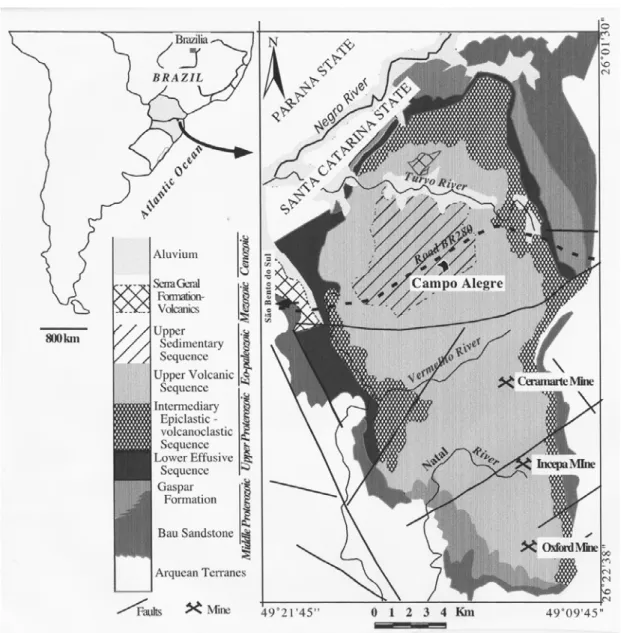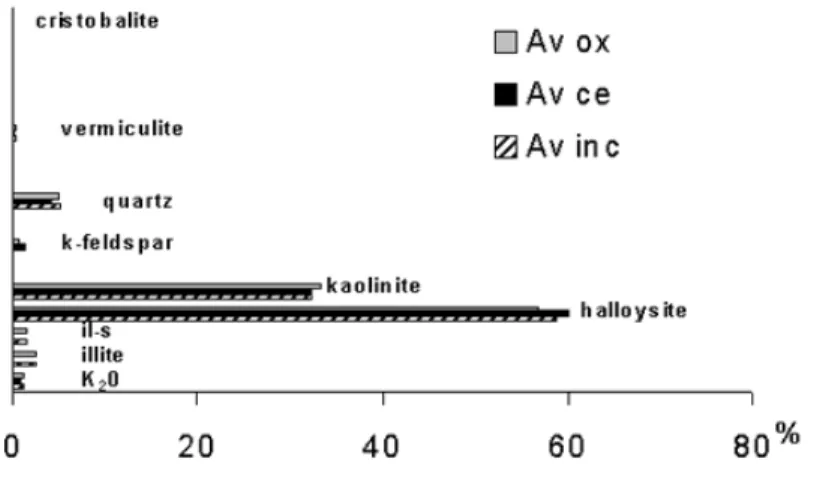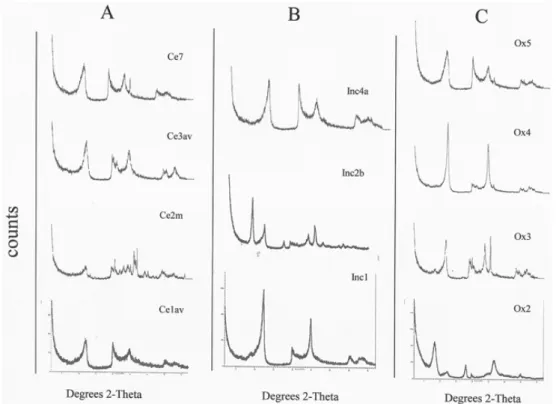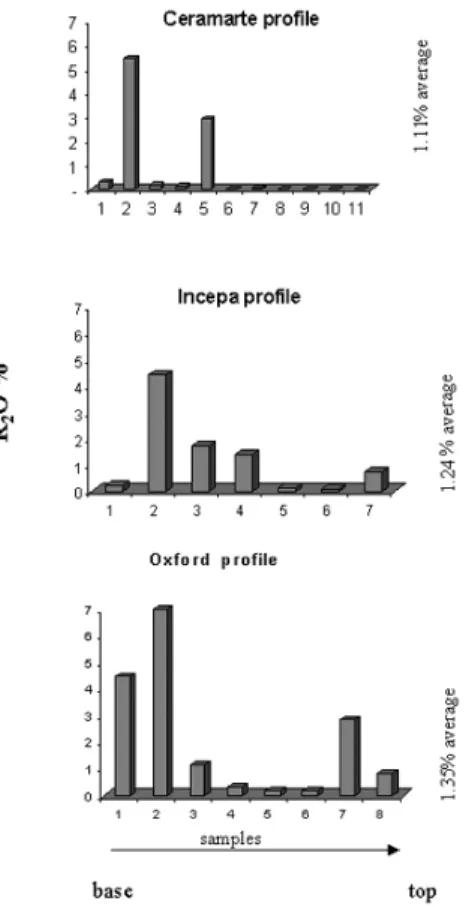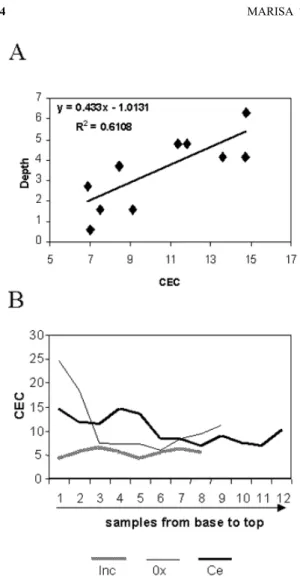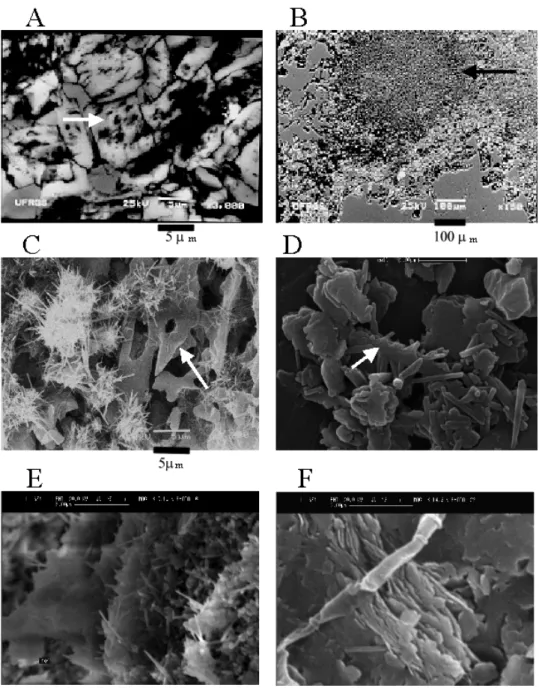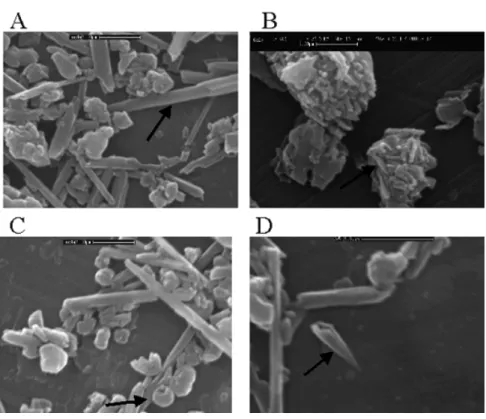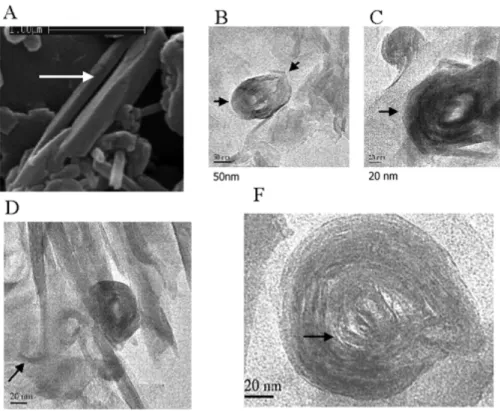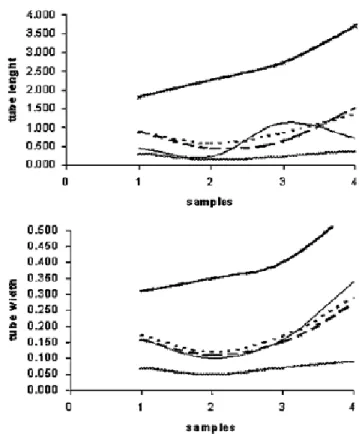91509-900 Porto Alegre, RS, Brasil
2Universidade Federal de Santa Catarina, Trindade – 88040-970 Florianópolis, SC, Brasil
3Centro de Estudos em Petrologia e Geoquímica, Instituto de Geociências, Universidade Federal do Rio Grande do Sul
Av. Bento Gonçalves, 9500 – 91509-900 Porto Alegre, RS, Brasil
4Department of Earth and Marine Sciences, DEMS Building 047, Australian National University, ACT 0200 Australia
Manuscript received on October 13, 2005; accepted for publication on September 10, 2006; contributed byMILTONL.L. FORMOSO*
ABSTRACT
Kaolin at Campo Alegre Basin, Santa Catarina State, Brazil was formed from alteration of volcanic acid rocks. Halloysite clays dominate the clay fraction of the matrix of the kaolin body, whereas a poorly crystalline kaolinite is abundant in veins. Some primary blocky structures have high amounts of illite, in one mine, but in general, only low contents of illite-smectite, illite, chlorite-vermiculite, vermiculite and quartz were identified in the clay fraction of the samples. Toward the top of the mines, hematite and lepidocrocite appear in horizontal red and ochre colored levels and the amount of kaolinite increases compared to halloysite. The vertical zoning of alteration levels, the changes in mineralogy, the positive correlation between depth and Cation Exchange Capacity of the clays, the preservation of different types of rock textures in the kaolin bodies, the dominant tube morphology of the halloysite clays indicate a supergene genesis for the deposits. Criteria to distinguish between supergene and hypogene kaolin are discussed. Transmission Electron Microscopy of the cross sections of halloysite tubes showed polygonal forms that are ascribed to be transitional between kaolinite and halloysite. It is proposed that some of the kaolinite of these deposits be inherited from the dehydration of halloysite tubes.
Key words:kaolinite, halloysite, halloysite morphology, kaolin, weathering, clay genesis.
INTRODUCTION
Campo Alegre Basin is an important source of clays for the ceramic market of the Mercosul and a place of a well-developed ceramic industry; however, these clays have been little studied. Kaolin deposits of Campo Alegre Basin resulted from the alteration of acid rocks of the upper volcanic unit of Campo Alegre Formation (Neo-proterozoic). The bedrock is composed of rhyolitic and trachytic lava interspersed with pyroclastic material
ei-*Member Academia Brasileira de Ciências
Correspondence to: Marisa Terezinha Garcia de Oliveira E-mail: marisa.oliveira@ufrgs.br
ther coarse or thinly laminated (Ebert 1971, Daitx and Carvalho 1980). The origin of these deposits is contro-versial: Biondi et al. (1999) stated they were formed by hydrothermal activity; Oliveira et al. (2000) showed co-existence of halloysite and kaolinite in one mine of the deposit and also showed evidences of a supergene origin. Few data on the mineralogy, chemistry and morphology of the clays are available.
The objectives of this work are:
min-eralogy, chemistry, cation exchange capacity, mor-phology) applying several methods which is useful for mineral exploration.
– Present new data on the crystal morphology of the kaolin clays of this deposit, and in particular to describe transitional forms between halloysite and kaolinite, and implications for the interpretation of geological history.
LOCATION AND GEOLOGICAL SETTING
Kaolin was formed from the alteration of volcanic acid rocks, near São Bento do Sul, Santa Catarina State, Brazil (Fig. 1). These rocks are components of Campo Ale-gre volcanic-sedimentary basin (Citroni et al. 2001) of almost 400 km2. It is a Neoproterozoic sequence (595±
16 Ma, Cordani et al. 1999) lying on older Archean gran-ulite terranes. Rhyolite is the most abundant lithotype (Weischel et al. 2000), but the rocks are heterogeneous: trachytes, porphyritic rhyolites, banded rhyolites, tuffs, breccia. The Lower Effusive Sequence is composed of basalt and trachyte. The Intermediary Epiclastic-volca-noclastic Sequence is made of shale and volcanogenic sedimentary and pyroclastic flow. The Upper Volcanic Sequence (80% of the exposed area) of late Proterozoic age consists of trachytes and rhyolites. Pyroclastic flow deposits are common as welded high temperature ign-imbrites (Weischel et al. 2000). Old rocks in a plateau up to±1000 m above sea level, fractures and faults are
evidences of a regional uplift (Potter 1997) in the area. Thick (20-40 m) deposits of clays evolve from the surface rocks. Three kaolin mines in Campo Alegre Basin were studied: Oxford (or Floresta) Mine, Incepa (or Cambuí) Mine and Ceramarte Mine (Table I).
Ceramarte Mine (26◦15′21"S–49◦12′55"W) is lo-cated in a down-slope landscape near the centre of Cam-po Alegre Basin. The mine is 7 to 17 meters deep and exposes differentiated levels over the altered porphyritic rhyolite. At the base the rhyolite alters to a saprolith horizon that maintains the rock texture; the saprock has elongated core boulders and preserves the rhyolite tex-ture and veins of white clays. As the alteration evolves, a network of clayey white segregations becomes denser within a light pink matrix and the rock texture disappears. An oxidate facies with yellow and red spots develops in
the clay zone about 3 to 7.5 meters up. The clay zone has anastomosing veins composed of white clays. Black organic soil develops over the white clays.
Incepa Mine (26◦17′27"S–49◦16′48"W) is approx-imately 30 m deep. At the base of the mine there are some relicts of the rock (aphanite) in a light greenish gray clayey matrix cut by fractures, coated with white clays. At some points higher in the profile, the matrix shows a very fine (less than 1 mm) laminated white and pale red structure with some very coarse (more than 10 mm) white granular structures. At the top of the sequence, located in a geomorphic depression, there is a 2 m thick black-colored soil.
Oxford Mine (26◦19′54"S–49◦12′50"W) is the third studied occurrence, in the south of Campo Alegre Basin. Kaolin forms from a banded rock with flow struc-ture planes alternating with more or less clayey material; along the planes there are black coatings. Towards the surface, the rock turns into a white to gray clay with rounded or sub-angular coarse blocky structures (up to 50 cm diameter) of green clay. Veins coated with white clay cut all the matrix of the mine walls. Higher in the profile, there is a red level (1 m thick) which is followed by an ochre level (1.5 m thick), which in turn is covered by a white clay soil with black roots.
MATERIALS AND METHODS
Twenty-six samples from the three mines were studied: 7 from Incepa, 8 from Oxford and 11 from Ceramar-te Mine. They were split into sub-samples for various methods of investigation.
Thin sections of impregnated samples were studied using scanning electron microscopy.
The clay (<0.002 mm) fraction of each sample was removed after settling under gravity according to Stock’s Law in an aqueous solution of 33 g of sodium hexametaphosphate and 7 g of anhydrous sodium carbon-ate in distilled wcarbon-ater (1 liter). Two oriented aggregcarbon-ates of each sample were prepared for Ba saturation and Mg saturation.
Cation exchange capacity (CEC) was determined by barium saturation as described by Janik and Keeling (1996). The oriented samples saturated with barium (1M
BaCl2) solution were washed several times with
Alterite vein 4.15 CE3av Light greenish gray (Gley8/1) within a light pink matrix Alterite 4.15 CE3bm White (2.5YR 8/1) The saprock has elongated core Vein of altered rhyolite 4.80 CE2bv Very Pale Brown (10YR8/2) boulders and preserves the rhyolite Altered rhyolite 4.80 CE2am Pink (5YR 7/3) texture and veins of white clays
Rhyolite 6.30 CE1av White (Gley 8/N) Rhyolite
Alterite 11.65 CE9 White Sample in the sequence
Incepa Mine (26◦17′27"S–49◦12′48"W)
Part of profile Depth Label of Color of bulk sample Description geomorphic depression
(m) sample Top→Base (30 m deep)
Granular structure 4 Inc5 White (Gley 8/N) 2m thick black-colored soil covers Brittle laminated matrix 5 Inc4b White/pale red (10R 7/2) the clays
Laminated matrix 5 Inc4a White/pale red (10R 7/2) Saprolite has a very fine (less than Clay Matrix 7.30 Inc3 White (Gley 8/N) 1 mm) laminated white and pale Green indurate relict 7 Inc 2b Light greenish gray (Gley8/10Y) red structure with some very Gray indurate relict 7 Inc2a Light greenish gray (Gley8/10GY) coarse (more than 10 mm) white Oriented veins 7 Inc 1 White (Gley 8/N) granular structures
At the base of the mine there are some relicts of the rock (aphanite) in a light greenish gray clayey matrix cut by fractures, coated with white clays
Oxford Mine (26◦19′54"S–49◦12′50"W)
Part of profile Depth Label of Color of bulk sample Description
(m) sample Top→Base (20 m deep)
Soil 1 Ox8 White (Gley 8/N) White clay soil with black roots
Yellow level 1.5 Ox7 Yellowish brown (10YR 5/6) Ochre level
Red level 2 Ox6 Red (2.5YR 5/8) Red level
Matrix 10 Ox5 White (Gley 8/N) Saprolite is a white to gray clay with
Vein 11 Ox4 White (Gley 8/N) rounded or sub-angular coarse
Matrix 15 Ox3 Light greenish gray (Gley 8/5GY) blocky structures (up to 50 cm Green fragment 16 Ox2 Light greenish gray (Gley 8/5BG) diameter) of green clay. Veins Rock with flow structure 20 Ox1 Very pale brown (10YR 8/2) coated with white clay cut all the
matrix of the mine walls Banded saprock with flow structure
Fig. 1 – Location and geology of Campo Alegre volcanic-sedimentary basin. The Lower Effusive Sequence is composed of basalt and trachyte. The Intermediary Epiclastic-volcanoclastic Sequence is made of shale and volcanogenic sedimentary and pyroclastic flow. The Upper Volcanic consists of trachytes and rhyolites. Three kaolin mines were studied: Oxford (or Floresta) Mine, Incepa (or Cambuí) Mine and Ceramarte Mine.
by XRF to determine barium content and hence CEC. The Mg saturated samples for X-ray Diffraction analysis were dried in air, ethylene glycol solvated, for-mamide treated, and heated up to 110◦, 350◦and 550◦C. Quantitative analyses of the clay separates were done
with SiroquantTM software, using X-ray diffraction of
random preparations.
Chemical analyses of 11 bulk samples were ob-tained with X-ray fluorescence in the Geology Depart-ment, ANU.
Clays deposited from ethanol suspension onto
alu-minum stubs, were dried at 40◦C and then gold coated
(20ηm) for observation in a Cambridge S360 SEM with
Tracor Northern EDXA.
Analysis of particle shape was made by applying NIH Image software to Adobe PhotoShop images of SEM photomicrographs. From each particle NIH im-age provided area and the length of the major and minor axes of the best fitting ellipse.
im-Fig. 2 – The overall distribution of the minerals along the three mines. The lines represent the average of mineral % in each mine. Av = average, Inc = Incepa, Ce = Ceramarte, Ox = Oxford.
pregnated with Spurr resin. After two weeks the sam-ples were heated up to 60◦C for 24 hours, then cut with a Reichelrt ultramicrotome, mounted on copper grids and coated with carbon. A Philips 430 EM, 300 kV at EMU-ANU and a Philips CM TEM 300 kV, Gatan Cam-era, at the Research School of Earth Sciences (ANU) were used.
RESULTS AND DISCUSSION XRD-MINERALOGICALCOMPOSITION
Data were obtained by quantification on the X-ray dif-fractograms of random preparations of the clays ana-lyzed with the SIROQUANT software and are shown in Table II as well as the name and the character of the samples (rock, regolith, vein, soil, etc).
In the three kaolin bodies, kaolin minerals halloy-site and kaolinite are the main constituents. Exceptions are samples Ox1, Ce2m, Ce3b that correspond to sap-rocks with high percentages of K-feldspar; sample Ox2 has high percentage of illite. Figure 2 shows the overall distribution of the minerals along the three mines ob-tained from averages of the % mineralogy of Table II. Halloysite is the most abundant clay mineral in the three mines. Only in two samples of veins (Ce2av and Inc5, Table II) the amounts of kaolinite are higher than hal-loysite.
The XRD diffractograms of oriented, air-dried pre-parations of representative samples of the three mines are presented in Figure 3.
The veins in the rock (rhyolite) of Ceramarte Mine (Fig. 3A-Ce1av) are composed mostly of halloysite. The saprock (Fig. 3A-2bm) still contains K-feldspar. The veins in the saprock contain kaolinite of a high-defect type (Fig. 3A-Ce3av) with Hinckley Index of 0.6. The upper saprolite (Fig. 3A-Ce7) is made of halloysite, kaolinite and traces of quartz.
Clays from Incepa Mine have illite (Fig. 3B-Inc 2b) in the saprock but not in the veins (Fig. 3B-Inc1); illite totally disappears in the clayey upper levels (Fig. 3B-Inc4b).
In the Oxford Mine some primary block structures showed high amounts of illite (Fig. 3C-Ox2), but in gen-eral, only low contents of illite (aver-2%), illite-smectite (aver-1.5%), quartz (aver-5%), microcline (aver-1%), vermiculite (aver-0.4%), and chlorite-vermiculite were identified in the clay fraction of the studied samples. The highest % of kaolinite (42%) occurs in the veins (Fig. 3C-Ox4), and the highest % of halloysite occurs in the clayey matrix (Fig. 3C-Ox5).
Toward the top of the mines, iron oxides concentrate in a red (hematite) level followed (in Oxford Mine) by an ochre (lepidocrocite) level. Also some other minor mineral components were detected: gibbsite and anatase (Oxford Mine); cristobalite (Ceramarte Mine).
CHEMISTRY OFCLAYS
TABLE II
The kaolin samples from Campo Alegre Basin.
XRD-Mineralogy (%) of the clay fraction quantified with Siroquant Software
Oxford
Character K- Illite Hallo Kaol Qtz. Verm Lepid Chlor C-V Gibb Anat He Cris.
Samples felds
Ox1 Rock with flux structure 52.5 6.4 34.5 0.5 4.5 1.5
Ox2 Blocky structure 89.3 2.1 1.7 0.6 6.4
Ox3 Matrix in the regolith 11.4 44.1 35.9 7.3 1.3
Ox4 Vein 54.8 42.0 1.0 2.1
Ox5 Matrix in the regolith 70.4 24.7 1.1 0.2 0.6 3
Ox6 Red Level 65.7 24.7 1.9 0.6 1.6 5.4
Ox7* Ochre Level x x x x x x x
Ox8 Top soil 54.5 35.7 1.1 0.7 0.7 7.3
Incepa
Character K- Illite Hallo Kaol Qtz. Verm Lepid Chlor C-V Gibb Anat He Cris.
Samples felds
Inc1 Vein in the saprock 50.9 49.1
Inc2a Saprock 20.9 43.7 22.1 13.2
Inc2b* Grey Saprock x x x x x
Inc3* Clayey matrix x x x x x
Inc4a Laminated matrix 77.6 21.9 0.1 0.5
Inc4b Brittle laminated matrix 79.7 14.7 5.6
Inc5 White granular structure 27.6 69.9 2.4 0.2
Ceramarte
Character K- Illite Hallo Kaol Qtz. Verm Lepid Chlor C-V Gibb Anat He Cris.
Samples felds
Ce1av Vein in the rock 68.2 26.7 5.1
Ce2av Vein in the saprock 44.2 55.1 0.7
Ce2m Saprock matrix 48.0 36.0 8.3 7.7
Ce3av Vein in the saprock 54.4 45.6
Ce3b Saprock matrix 32.3 48.7 14.2 4.8 0.1
Ce4acd Vein in Oxidized facies 69.3 28.3 1.3 0.9
Ce5a Clayey level 90.8 7.2 1.7 0.4
Ce6a Vein 58.9 36.5 3.5 0.3 0.8
Ce6b Matrix of the saprolite 51.8 41.2 1.6 0.2 0.2 5.2
Ce6c Vein 57.5 41 1 0.4 0.2
Ce7 Upper saprolite 60.7 36.4 3.2
Ce9 Pallid Zone 49.2 48.2 2.5
Ce10 Pallid Zone 55.5 39.7 4.9
*samples that were not quantifiable with siroquant, x represents the mineralogy of the clay fraction, K-felds = K-Feldspar, Illite/I-S = Illite or Illite-Smectite, Hallo = Halloysite, Kaol = Kaolinite, Qtz. = Quartz, Verm = Vermiculite, Lepid = Lepidocrocite, Chlor = Chlorite, C-V = Chlorite-Vermiculite, Gib = Gibbsite, Anat = Anatase, He = Hematite, Crist = Cristobalite.
Chemical analyses of bulk samples showed that the veins have kaolinitic composition, the samples of the matrix have high amounts of SiO2due to quartz and
the green clay of the blocky structures from Oxford Mine has higher K2O content than the other samples.
Fe2O3contents vary from 3.15 wt. % in the
green-clay sample from Oxford Mine, to 0.185 wt. %, in the veins of Incepa Mine.
TiO2values are from 0.51 to 0.01 wt. %. The lower
values are from samples of veins in the base of the mines and the higher ones are from samples from the top of the deposits.
The K2O content composition may be a good
mea-sure of the degree of the alteration of the primary miner-als. The lower the K2O value the high alteration degree
of the sample. Table IIIb shows the K2O content of the
clay fraction from samples from Ceramarte Mine, Incepa Mine and Oxford Mine. It indicates that Ceramarte Mine has a high degree of alteration but not the highest because at Incepa and Oxford the presence if illite, which is more resistent than K-feldspar (of Ceramarte), may invalidate this measure of comparison.
Figure 4 shows the relation between K2O content
decreas-Fig. 3 – XRD-Mineralogical Composition (oriented aggregates) of representative samples of the kaolin clays at A – Ceramarte Mine, B – Incepa Mine, C – Oxford Mine.
TABLE III-a
XRF analysis (wt. %) of major elements of 11 bulk samples from kaolin clays of Campo Alegre Basin.
Mine Ceramarte Incepa Oxford
Type Vein in Vein Clayey Vein Upper Vein
Laminated Brittle Blocky Matrix Top of the in the in the level in the saprolite in the
matrix laminated structure- in the soil sample rock saprock matrix matrix matrix saprock matrix green clay regolith
label. ce1v ce3a ce5 ce6a ce7 inc1 inc4a inc4b ox2 ox5 ox8
SiO2 45.56 45.05 70.11 52.01 75.22 45.89 68.42 60.32 49.49 67.63 59.17
Al2O3 36.63 35.80 19.25 32.96 15.80 37.74 20.18 26.42 30.16 21.86 27.14
Fe2O3 0.84 2.12 0.45 0.58 0.41 0.19 0.50 0.29 3.15 0.35 1.03
MgO 0.04 0.15 0.03 0.04 0.03 0.06 0.04 0.04 0.94 0.08 0.24
MnO 0.00 0.01 0.00 0.00 0.00 0.00 0.00 0.00 0.04 0.00 0.01
TiO2 0.02 0.02 0.51 0.17 0.36 0.01 0.26 0.38 0.29 0.28 0.29
CaO 0.00 0.00 0.01 0.00 0.01 0.00 0.01 0.01 0.00 0.01 0.01
Na2O 0.17 0.01 0.00 0.02 0.03 0.00 0.01 0.02 0.02 0.01 0.02
K2O 0.10 0.08 0.04 0.04 0.06 0.18 0.26 0.15 5.95 0.30 0.90
P2O5 0.15 0.01 0.03 0.04 0.03 0.00 0.02 0.03 0.01 0.03 0.01
S 0.00 0.01 0.00 0.00 0.00 0.01 0.01 0.01 0.00 0.01 0.01
Total 83.52 83.25 90.42 85.86 91.95 84.06 89.70 87.66 90.06 90.56 88.82
ing values from base to the top of the profile. At Incepa
the samples have decreasing K2O values from base to
the surface but not sample 1 that is from a vein. The
samples from Oxford Mine also have decreasing K2O
av-TABLE III-b
XRF analysis (wt. %) of K2O clay fractions of samples from
kaolin clays of Campo Alegre Basin.
Ceramarte Incepa Oxford
1 Ce1v 0.31 1 inc1 0.22 1 Ox1 4.46
2 Ce2a 5.46 2 inc2b 4.41 2 Ox 2 6.99
3 Ce2b 0.19 3 inc2a 1.72 3 Ox 3 1.16
4 Ce3a 0.14 4 inc3 1.42 4 Ox 4 0.33
5 Ce3b 2.97 5 inc 4a 0.13 5 Ox 5 0.18
6 Ce4a 0.02 6 inc4b 0.09 6 Ox 6 0.19
7 Ce4b 0.06 7 inc5 0.71 7 Ox 7 2.84
8 Ce5a 0.01 8 Ox 8 0.80
8 Ce6a 0.03
10 Ce6b 0.03
11 Ce7 0.03
Average 1.11 Average 1.24 Average 1.35
erage K2O content of the clay fraction from Ceramarte
Mine is 0.97 wt. %; of Incepa Mine is 1.24 wt. %, and of Oxford Mine is 1.34 wt. %.
Fig. 4 – K2O content used as a measure of the degree of the alteration
of the primary minerals in the mines.
There is a positive correlation between CEC and depth in the Ceramarte Mine (Fig. 5 and Table III) as al-ready seen with K2O content, but not for the other mines.
The average CEC of Oxford Mine clays is the highest (11.2 meq/100g) and may be related to the presence of some Illite-Smectite. The average CEC of Ceramarte clays (10.3 meq/100 g) may be due to the observed very small length of halloysite tubes (mode 0.46µm in the veins of the rock; 0.22µm in the veins of the alterite). Clays from Incepa Mine have the lowest CEC average value (5.6 meq/100 g), possibly related to the highest tube width (mode 0.46µm).
MICROTEXTURES OF THECLAYS AND
ELEMENTALCOMPOSITION
Visible differentiations from the walls of each mine (Table I) were sampled. SEM observations and EDX Analysis of the small fragments and the thin sections were done in order to add new data on the mineralogy and composition of the bulk samples (Table IV).
Ceramarte Mine facies are composed of tubular
ob-amounts of Mg, Ti, Pb Saprolite 7Å–10Å Hallo (90.8) 10Å–7Å Hallo (77.6) 10–7Å Hallo (44) Clays with tube morphology
Kaolinite (7.2) Kaolinite (21.9) Kaolinite (35.9) are dominant with polygonal Quartz (1.7) Vermiculite (0.5) Illite (11.4) cross sections
Vermiculite (0.5) Quartz (0.1) Quartz (7.3) Chemical components of clays Vermiculite (1.3) are Si, Al, also K, Fe, Ti
in the illitic material Saprock 7Å–10Å Hallo (48.7) 10Å–7Å Hallo (43.7) K-feldspar (52.5) Inherited minerals weathers with
K-feldspar (32.3) Kaolinite (22.1) 10–7Å Hallo (34.5) different rates, K-feldspar Kaolinite (14.2) Quartz (13.2) Mica (6.4) appears with etch pit
Quartz (4.8) Illite (12.8) Quartz (4.5) formations
Vermiculite (0.1) Illite-smectite (8.1) Gibbsite (1.5) Chemical components of illitic Kaolinite (0.5) clays are Si, Al, K, Fe and
very few amounts of Mg, Zr and Ti
Rock Rhyolyte (K-feldspar, Tuff Breccia and fluidal
quartz, biotite) rhyolites
served (Ce1Av). Inherited grains of K-feldspar appear at the base of the mine showing differential alteration as “etch-pit formation” (Fig. 7A), but disappear throughout the top. The spherulitic texture of the rhyolite, due to crystallization of the volcanic glass, is also observed in the samples from the base of the Mine both in thin sec-tion and in small fragments and is related to the very fast cooling rate of the high temperature acid flows. The ar-row in the thin section photomicrograph (Fig. 7B) points the spherulitic texture of the rhyolite. In a small fragment the porous structure of the spherulite, made of neddles of quartz (Fig. 7C) contains halloysite aggregates.
In the pallid zone of Ceramarte Mine an aggregate of halloysite tubes that apparently merge into kaolin stacks was observed (Fig. 7D).
Incepa Mine facies are composed of tubular and
platy xenomorphic crystals of halloysite and kaolinite (Si, Al), some platy xenomorphic crystals of illite (Si> Al≫K>Fe), and laths of Vermiculite. Some relicts of the rock (aphanite) are indurated with quartz box-work. A finely laminated white and pale red facies at 4 m depth from the surface is seen by SEM to be caused by layers of halloysite tubes and spheres intercalated with kaolinite plates (Fig. 7E).
Oxford Minedisplays the greatest diversity of clay particles. The Gley 8/5BG clays with the blocky struc-ture (16 m depth) showed dominantly platy xenomor-phic crystals of illite (Si>Al≫K>Fe), little illitic material of platy xenomorphic crystals without iron (Si>Al≫K) and lath-shaped crystals with irregular
Fig. 5 – (A) correlation between CEC of the clays and depth in Ce-ramarte Mine and (B) the variation of CEC with depth in the three Mines.
The wall of the mine (matrix) is a light greenish-gray clay composed of tubular and platy xenomorphic crystals of halloysite and kaolinite (Si, Al), pyramidal crystals of quartz (beta-form), platy xenomorphic crys-tals of illite (Si>Al≫K>Fe) and lath-shaped crystals with irregular ends (Si≫Al).
The white veins in the wall (11 m depth) are com-posed of platy xenomorphic crystals of kaolinite, tubes of halloysite (Si=Al) and platy xenomorphic crystals of illite (Si>Al≫K>Fe). These clays also showed very small amounts of Mg, and Ti and Pb.
The red level (2 m depth) is composed of tubes of halloysite (0.3µm width) and platy xenomorphic crys-tals of halloysite and kaolinite. Other components as
Fig. 6 – Iron-rich platy crystals of kaolinite forming stacks in the veins (CE2v). The iron was detected by the EDX Analyses with the SEM.
hematite and anatase were not observed at this scale of magnification (9.000-14.000 x).
Finally the yellowish brown level (1.5 m depth) al-most at the top of mine is composed of tubes and platy xenomorphic crystals (Si = Al>Fe≫K>Ti) of halloy-site and kaolinite. The Fe and Ti detected in these par-ticles may be related to very small amounts of lepido-crocite and anatase observed in the XRD analysis.
The white soil (Gley 8/N) at 1m depth is composed of tubes and platy xenomorphic crystals of halloysite and kaolinite and small quantity of laths with regular ends (Si>Al≫K>Fe or Si = Al≫Ti>Fe) of vermi-culite. Also Ti (anatase) was detected mixed in the clays.
MORPHOLOGY OF THEPARTICLES
Halloysite exhibits tubular, spherical and cone-shaped morphologies throughout the clay fraction (<2µm)of the three mines. Arrows of Figure 8 points to: Tubes are the most common, and they often show some flat surfaces (Fig. 8A). There are very small(0.14µm)tubes (Fig. 8B), short tubes(0.8µm), and long tubes(3µm). The spherical halloysite appears in all the three mines. The spheres are very small(< 0.5µm)and are interspersed with the other particles (Fig. 8C), except in the Incepa Mine, where they form layers. Cone morphology and partly rolled tubes were also observed (Fig. 8D).
cross-Fig. 7 – Microtextures of the clays: (A) inherited grains of K-feldspar at the base of Ceramarte mine showing "etch-pit formations"; (B) the arrow in the thin section photomicrograph points the spherulitic texture of the rhyolite; (C) in a small fragment, the porous structure of the spherulite, made of neddles of quartz, contains halloysite aggregates; (D) in the pallid zone of Ceramarte Mine it was observed that an aggregate of halloysite tubes apparently merge into kaolin stacks; (E) the stratification at Incepa saprolite is due to layers of halloysite tubes and spheres intercalated with kaolinite plates; (F) blocky structures in Oxford mine showed platy xenomorphic crystals of illite and also lath-shaped crystals with irregular ends. Photomicrographs D, E and F have graphic scale=1µm.
sections of tubes. TEM showed different types of cross-sections: i) mixed curved and linear external shape with a circular internal hole and pores between the smoothly curved layers (Fig. 9B), polygonal with a polygonal
Fig. 8 – Variety of halloysite morphologies: tubes (A), small tubes between kaolinite plates (B), spheres that are scarce (C) and partly rolled tube or cone (D). Graphic Scale=1µm.
MEASUREMENTS OFHALLOYSITEPARTICLES
The clay separates of three samples of Ceramarte Mine were chosen because of their different values of CEC and because of their location in the profile. One sample of Incepa Mine that showed a low CEC value (4.4) was also statistically analyzed in order to obtain quantitative morphological data of the length and width of the hal-loysite particles. Also a sample from Oxford mine was analyzed. Statistic data are recorded in micrometers in Table V. Sample Ce1v is from white clays in a vein in the saprock, Ce2v is from very pale brown clay in a vein in the saprolite; sample Inc4a,b is from a laminated matrix of Incepa Mine. Also the clay sample Ce9 that is from the upper pallid zone was analyzed. Curves representing the minimum, mean, median, mode and maximum tube length for each sample are in Figure 10A and tube width in Figure 10B.
Figure 10A shows that particles of sample CE2v have the lowest statistical values of the four samples, ex-cept the value of max length. Particles of sample Inc4a,b
have the highest statistical values of the four samples, except the value of mode length.
Figure 10B also shows that particles of sample CE2v have the lowest statistical values of the four sam-ples, except the value of max width. Particles of sample Inc4a,b have the highest value of maximum width.
COEXISTENCE OFHALLOYSITE ANDKAOLINITE
Halloysite and kaolinite coexist in Campo Alegre as well as in several other kaolin deposits (Murray and Keller 1993). Why both minerals occur? Is there any relationship between halloysite and kaolinite with differ-ent precursors? Are they related to differdiffer-ent microenvi-ronments? Jeong (1998) observed that genetic relation between the two minerals in the weathering environment is rarely established.
alumino-sili-Fig. 9 – Tubes are the most common morphology for halloysite observed using SEM. Planar surface (A) are common. TEM observations of cross-sections of the tubes showed curved shape as well as polygonal shape in the same particle (B). Other cross sections of tubes are polygonal (C). Some unrolled cross sections form plates (D). Also circular cross-sections with pores between the smoothly curved layers (E) were observed.
cate of the rocks, it can be assumed it is the kaolin precursor. Under conditions of good drainage in the hu-mid tropics, K-feldspar weathers to give hollow tubes of halloysite (Parham 1969). Also Banfield and Eggleton (1990) observed a mineralogical pathway in K-feldspar weathering, starting in etch pits and cracks with the for-mation of cell-textured materials of allophane compo-sition, smectite, a second protocrystalline material and spherical halloysite. After dissolution formed networks of cavities, Al and Si precipitated from solution and re-sulted the growth of tubular halloysite.
The origin of the kaolinite needs other interpreta-tions. In Campo Alegre kaolin deposits, kaolinite occurs as (iron-rich) stacks filling veins either in the rocks or in the saprolite, or as tight aggregates in the saprolite. At Incepa and Oxford Mines also illite and illite-smectite (inherited from pyroclastic rocks) are mixed in the ma-trix and could be remaining of a hydrothermal process.
hal-Fig. 10 – Maximum (upper line), mean (dotted line), mode (fine line), median (dashed line) and minimum (lower line) tube lengths and the same statistic values of tube widths of samples 1 (Ce1), 2 (Ce2), 3 (Ce9), and 4 (Inc4a-b).
loysite tubes, is also possible. Singh (1996) explained how the 1:1 structure switches from halloysite to kaoli-nite: as a result of prolonged dehydration, hydrogen bonding between layers gradually became stronger, and the structure shifts from rolling mechanism to tetrahe-dral rotation, causing tubes to produce laths by unrolling. Wouatong et al. (1996) observed this morphological transformation (unrolled spherical-shaped halloysite to tubular and finally unrolled again producing platy kao-linite) in a granite saprolite. Present study observed the following sequence of morphological changes in hal-loysite particles (Fig. 11) in a weathering profile: Tubes – Tubes with planar faces and internal cylindrical holes – Tubes with planar faces and internal hole with planar walls-unrolled tubes-plates. The correlation of the forms with depth is not linear. All the forms occur along the weathering profile, but the transitional forms between tubes and plates were observed most frequently in the samples near the surface.
The end members of the solid-state halloysite to kaolinite transformation at Campo Alegre basin are low Hinckley Index and very broad basal peaks kaolinites, similar to the end-members kaolinites described by Jeong (1998). All observations agree that halloysite is a meta-stable mineral at Campo Alegre basin, and transform to stable kaolinite with aging (weathering).
CONCLUSIONS
This study resulted in the following conclusions:
– The kaolin from Campo Alegre Basin is composed of halloysite (10 Å and 7 Å) and disordered kaoli-nite. Halloysite content is higher than kaolinite, except in some veins; low abundant minerals are quartz, K-feldspar, illite, illite-smectite, vermicu-lite, anatase, hematite and lepidocrocite.
Fig. 11 – Observed morphological changes in the halloysite particles: Tubes (A), tubes with planar faces with internal cylindrical holes (B), tubes with internal and external planar faces (C), unrolling tubes (D, E, F). The sequence of changes in morphology (A→B→C→D→E) due to dehydration of halloysite, evolves into platy kaolin particles. Small numbers correspond to position in meters of depth in the profile.
both rounded and polygonal cross-sections. The planar faces of the tubes with polygonal cross-sec-tions are due to dehydration.
– Kaolinite is interpreted to have two likely origins: the weathering of illitic material from pyroclastic rocks (Incepa and Oxford Mine) and the dehydra-tion of halloysite at or near the upper part of the weathering profiles. The observed sequence of mor-phological changes in halloysite to kaolinite parti-cles is – tubes – tubes with planar faces and internal cylindrical holes – tubes with planar faces and inter-nal hole with planar walls – unrolled tubes – plates.
ACKNOWLEDGMENTS
The authors thank Electronic Microscopy Unit of the Australian National University, Dr David Lewellyn help with the TEM, Robin Westcott and Alain Meunier.
RESUMO
TABLE V
Measurements of the area, length and width of hal-loysite tube particles in SEM photomicrographs, from 3 samples of the Ceramarte Mine, and two sam-ples of Incepa Mine, measured with NIH software.
Ce1 tube length tube width (104 particles) (µm) (µm)
min 0.290 0.070
maxi 1.800 0.310
mean 0.880 0.173
mode 0.460 0.160
median 0.890 0.160
standard dev 0.32172 0.04727 Ce2 tube length tube width (107 particles) (µm) (µm)
min 0.130 0.050
max 2.260 0.350
mean 0.583 0.120
mode 0.220 0.100
median 0.455 0.110
standard dev 0.439042 0.049923 Ce9 tube length tube width (74 particles) (µm) (µm)
min 0.220 0.070
max 2.730 0.400
mean 0.848 0.168
mode 1.130 0.160
median 0.640 0.150
standard dev 0.5637 0.0659 Inc4 (a,b) tube length tube width (99 particles) (µm) (µm)
min 0.380 0.090
max 3.710 0.570
mean 1.363 0.287
mode 0.710 mode 0.46µm
median 1.520 0.270
standard dev 0.67579 0.091444
foram identificadas, na fração argila das amostras, baixas quan-tidades de ilita-esmectita, ilita, clorita-vermiculita, vermiculita e quartzo. Em direção ao topo das minas aparecem hematita e lepidocrocita em níveis vermelhos e ocres e as quantidades de caolinita aumentam, se comparadas às de haloisita. O zonea-mento vertical dos níveis de alteração, as mudanças minera-lógicas, a correlação positiva entre profundidade e Capacidade
de Troca de Cátions das argilas, a preservação de diferentes tipos de textura de rochas nos corpos de caolim e o predomínio da morfologia tubular da haloisita indicam uma origem su-pergênica para os depósitos. São discutidos critérios para dis-tinguir entre caolins supergênicos e hipogênicos. A Micros-copia Eletrônica de Transmissão das secções transversais dos tubos de haloisita mostrou formas poligonais que são atribuídas a transições entre caolinita e haloisita. Propõe-se que algumas das caolinitas destes depósitos sejam herdadas da desidratação de tubos de haloisita.
Palavras-chave: caolinita, haloisita, morfologia da haloisita,
caolim, intemperismo, gênese de argilas.
REFERENCES
BANFIELDJANDEGGLETON RA. 1990. Analytical Trans-mission Electron Microscope Studies of Plagioclase, Muscovite, and K-feldspar Weathering. Clays Clay Miner 38: 77–89.
BIONDIJC, VANZELAGAANDBARTOZEKMK. 1999.
Pro-cessos químicos de gênese de depósitos de argilominerais a partir de rochas vulcânicas da formação Campo Alegre, SC. Geoch Bras 13: 121–143.
CITRONI SB, BASEI MAS, SIGAJR OANDNETO JMR.
2001. Volcanism and Stratigraphy of the Neoproterozoic Campo Alegre Basin, SC, Brasil. An Acad Bras Cienc 73: 581–597.
CORDANIUG, BASEIMAS, SIGAJROANDNUTMANA. 1999. Idades U-Pb (SHRIPM) de rochas vulcânicas das Bacias de Campo Alegre, Itajai e Castro (SC e PR). Re-sumos. An Acad Bras Cienc 71: 835.
DAIXT EC AND CARVALHO MAS. 1980. Projeto Geo-química na Área de Guaratubinha-Pien, SC. São Paulo: DNPM/ CPRM.
EBERTH. 1971. O grupo Guaratubinha no norte do Estado
de Santa Catarina. In: CONGRESSO BRASILEIRO DE
GEOLOGIA25, SBG, São Paulo, SP, Brasil, p. 147–165. JANIKLJANDKEELINGJL. 1996. Quantitative
determina-tion of halloysite using FT-IR PLS analysis and its applicaton to the characterisation of kaolins from north-western Eyre Peninsula, South Australia. Divisional Re-port 129. Adelaide: CSIRO Division of Soils, 59 p. JEONG GY. 1998. Formation of vermicular kaolinite from
halloysite aggregates in the weathering of plagioclase. Clays Clay Miner 46: 270–279.
Earth Sci 10: 331–344.
ROBERTSONIDM AND EGGLETON RA. 1991. Weather-ing of granitic muscovite to kaolinite and halloysite and of plagioclase-derived kaolinite to halloysite. Clays Clay Miner 39: 13–126.
